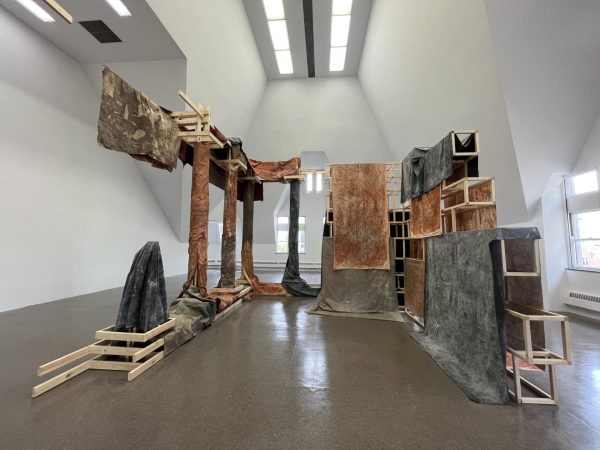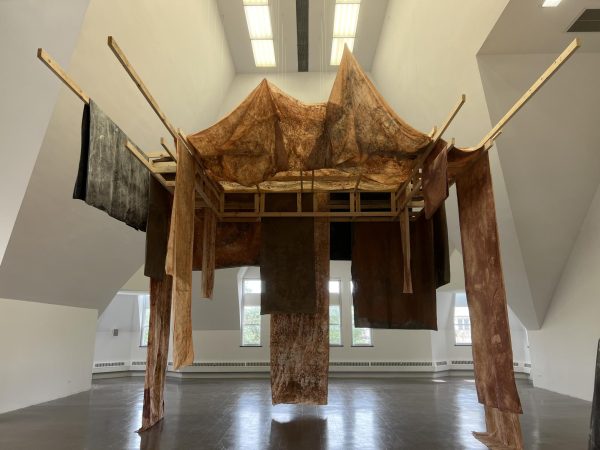Across civilizations, rivers—the Greek Styx, the Chinese River of Oblivion, and the Sumerian Hubur—have always been closely associated with death. Dala Nasser’s exhibition Adonis River, exploring rituals and ceremonial objects in mourning, is now on display at the Renaissance Society.
The motifs of Greek mythology and ritual are immediately evident as one steps into the Renaissance Society’s spacious gallery. To the left stands a column of wooden pillars and an L-shaped wooden lattice structure with dyed fabrics draped over them; to the right is a dome-like structure covered by fabric on top and at its sides. The column and lattice form the outline of a temple, while the dome is reminiscent of the cave in which Adonis and Aphrodite spent the night before his tragic death.

Nasser’s exhibition is grounded in the rich mythology of Adonis. Adonis, one of the paragons of male beauty in classical antiquity, was the mortal lover of Aphrodite. The grieving Aphrodite created the Adonia Festival to commemorate his death, and the annual ritual brought together the grieving women of ancient Athens. Even today, the Adonis River—now known as the Abraham River—is culturally significant as local people hang out the ill’s clothes as a prayer for their recovery.
Nasser painted the fabrics on-site at the Abraham River, mixing the iron-oxide-rich local clay with ash to produce subdued, layered hues, before washing the fabrics in the river water to produce flowing strokes. The pebbles and bits of clay scattered over the fabrics, adding variation to their texture. The fabric’s earthy redness simultaneously evokes Adonis’s blood flowing into the river waters, and the clay-rich soil of the valley that feeds the river and its tributaries. Blue-gray tones recall the shrouds displayed during mourning rituals like Ashura, a Shia Muslim day of commemoration that Nasser has referenced in her previous works.

One is continually reminded that this is a space for mourning through the consistent references to Adonis, and the sheer height of the exhibition, taking full advantage of the Renaissance Society’s expansive space, imposes a sense of somberness unto the viewer. This atmosphere of solemnity is heightened by the sound piece that accompanies the installation: in collaboration with artist Mhamad Safa, Nasser recorded mourning prayers and slowed them down by 40 times, and the composition is played on loop in the exhibition space. It starts off so soft that one hardly notices it—you get a small surprise when it crescendos, and then it becomes impossible for you to not notice it.
The prayers are slowed down by so much that you cannot make out what is being said, but as they echo around the room, you become completely immersed in this ritual of mourning that transcends time and space: it manifests in different forms, it is performed by different people, but its essence—an act of remembrance—endures. Thousands of years ago, people commemorated the death of a mythological figure at a river in Lebanon; Nasser invites her audience to step into an abstraction of that same world, here and now.
Adonis River is on display at the Renaissance Society through November 26, 2023.









